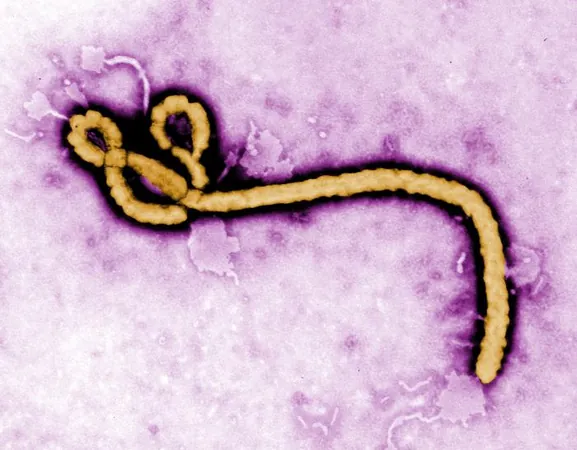
New Insights on Ebola: How Human Skin Could Facilitate Transmission
2025-01-02
Author: Mei
Introduction
In a groundbreaking study, researchers at the University of Iowa Health Care, alongside experts from the Texas Biomedical Research Institute and Boston University, have unveiled a novel model that sheds light on how the deadly Ebola virus (EBOV) transmits through human skin. Utilizing human skin explants, the team meticulously tracked the virus's journey through the skin's inner and outer layers, uncovering critical pathways that could be pivotal in person-to-person transmission during the later stages of infection.
Key Findings
The findings revealed that EBOV infects various cell types in the lower dermis before making its way to the superficial epidermis. Specifically, the researchers found that the virus infiltrates the outermost epidermis through engagement with different skin cells. This significant breakthrough not only confirms that human skin can actively sustain EBOV infection but also suggests that the skin surface might act as a transmission route between individuals.
Research Significance
Dr. Wendy Maury, a professor of microbiology and immunology at the University of Iowa and senior author of the published study in Science Advances, highlighted, “The skin is the largest organ in the human body yet is woefully understudied compared to most other organs.” She emphasized the importance of understanding how EBOV interacts with skin cells, stating that this knowledge is crucial for developing effective antiviral strategies.
Study Details
The study titled 'Multiple cell types support productive infection and dynamic translocation of infectious Ebola virus to the surface of human skin,' not only documents how infectious viruses make their way to the epidermal surface, but it also identifies the specific skin cells targeted during infection—an essential piece for future antiviral development.
Transmission Implications
Ebola, a hemorrhagic fever endemic in parts of East-Central and West Africa, is primarily transmitted through direct contact with the bodily fluids of an infected person. Various past outbreaks have shown that remnants of infectious Ebola can persist on the skin of patients, particularly during late-stage infections. The observation that the virus can be found on skin surfaces raises questions about contact transmission, particularly in crises where healthcare workers are at risk.
Previous Research
Previous animal studies corroborated that EBOV RNA and infectious particles were detectable on the skin of infected hosts. However, as the researchers noted, the mechanism by which the virus travels from inside the body to the skin and the specific skin cells involved has remained elusive until now.
Methodology
To further investigate, the research team devised a human skin explant model using full-thickness skin samples sourced from healthy individuals. By introducing viral particles to the underside of the skin in culture media, they effectively simulated the virus's journey from the bloodstream to the surface. Over a 17-day period, the researchers observed how the virus traveled from the dermis to the epidermis, discovering that within just three days, it reached keratinocyte cells at the skin's apex, indicating a rapid spread.
Critical Cell Types
Crucially, the study identified specific dermal cells—endothelial, myeloid, and fibroblast—as critical for EBOV infection. The researchers noted that keratinocytes, typically associated with skin functions, also supported viral replication in a way that had not been previously recognized, underscoring their potential role in the transmission.
Cellular Mechanisms
In a bid to understand the cellular mechanisms at play, the researchers conducted additional experiments revealing that two key proteins, NPC1 and AXL, play essential roles in facilitating the virus's entry into these skin cells. The use of purified human keratinocytes and fibroblasts confirmed that these cells are necessary for EBOV to establish an infection.
Research Impact
Dr. Kelly Messingham, research professor of dermatology and a lead contributor to the study, remarked that this research not only opens new avenues for understanding Ebola transmission but also lays the groundwork for exploring effective antiviral therapies. 'Our findings elucidate a mechanism by which EBOV traffics to the skin’s surface and may explain person-to-person transmission via skin contact,' Messingham concluded.
Future Directions
Moreover, the study points out the potential of human skin explants as invaluable tools for testing antiviral drugs, offering a cost-effective and accessible model to evaluate therapies before progressing to animal studies. As global health authorities continue to grapple with the complexities of Ebola outbreaks, this research may provide critical insights that lead to more effective containment strategies.
Conclusion
In the ongoing fight against Ebola, understanding every possible transmission route can be a game changer—this study is a big step towards unraveling those pathways. Stay tuned for more updates as research progresses and strategies evolve!



 Brasil (PT)
Brasil (PT)
 Canada (EN)
Canada (EN)
 Chile (ES)
Chile (ES)
 Česko (CS)
Česko (CS)
 대한민국 (KO)
대한민국 (KO)
 España (ES)
España (ES)
 France (FR)
France (FR)
 Hong Kong (EN)
Hong Kong (EN)
 Italia (IT)
Italia (IT)
 日本 (JA)
日本 (JA)
 Magyarország (HU)
Magyarország (HU)
 Norge (NO)
Norge (NO)
 Polska (PL)
Polska (PL)
 Schweiz (DE)
Schweiz (DE)
 Singapore (EN)
Singapore (EN)
 Sverige (SV)
Sverige (SV)
 Suomi (FI)
Suomi (FI)
 Türkiye (TR)
Türkiye (TR)
 الإمارات العربية المتحدة (AR)
الإمارات العربية المتحدة (AR)